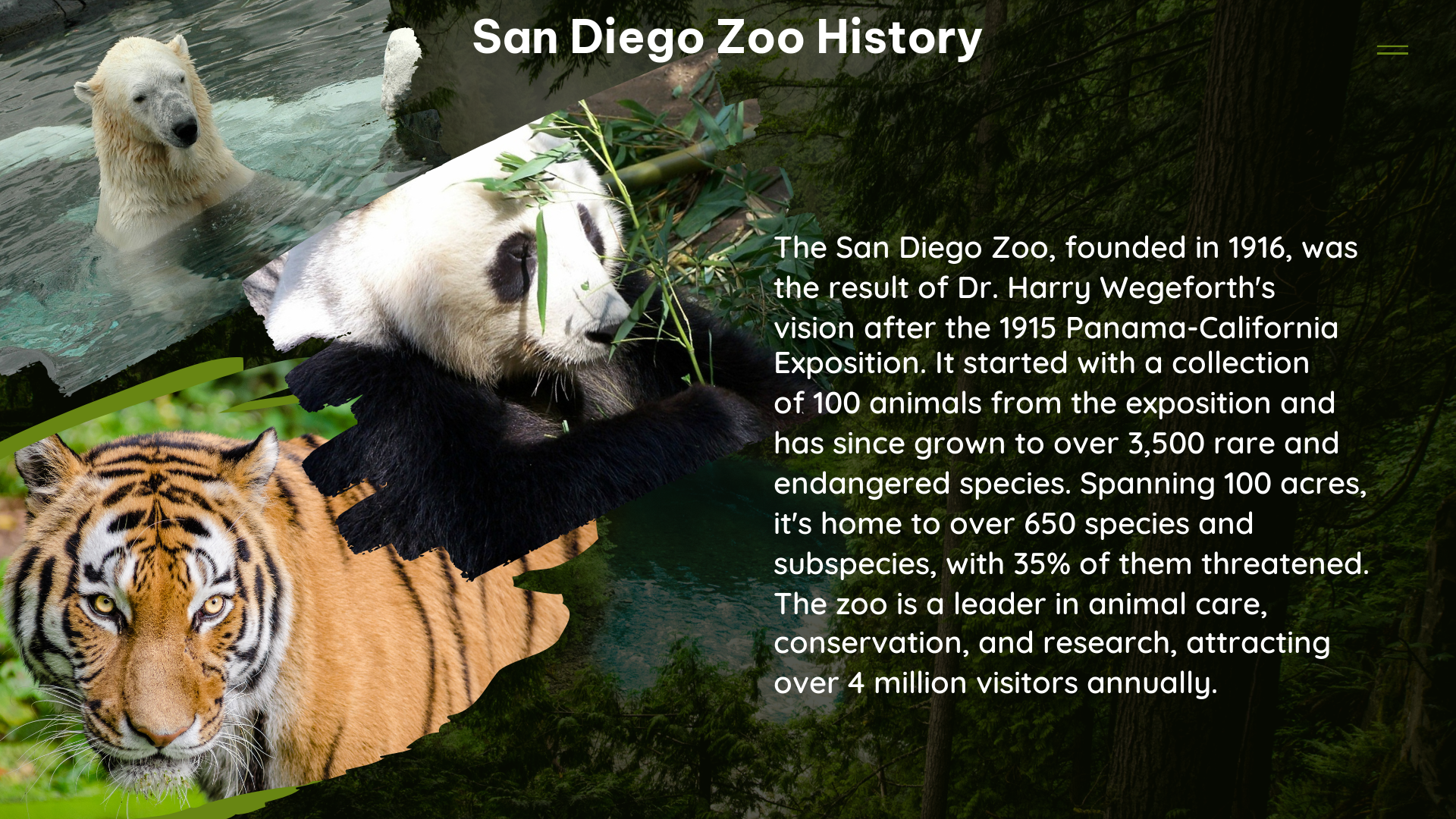The San Diego Zoo, one of the largest collections of exotic and endangered mammals, birds, and reptiles in the world, is located in San Diego, California, U.S. The municipal zoo, founded in 1916, is administered by the Zoological Society of San Diego. It occupies a 100-acre (40-hectare) site in the city’s Balboa Park amid a setting of hills and canyons. The zoo has about 4,000 animals representing more than 800 species.
The Humble Beginnings of the San Diego Zoo
In 1916, Dr. Harry Wegeforth, a local physician, drove past Balboa Park when he heard a lion’s roar. The lion was left behind from a small zoo exhibit at the 1915-1916 Panama–California Exposition in Balboa Park. After hearing the lion, Dr. Harry turned to his brother and half-jokingly said, “Wouldn’t it be splendid if San Diego had a zoo! You know…I think I’ll start one”. This side-remark grew in Dr. Harry’s mind, and he built a team consisting of his brother, Dr. Fred Baker, Dr. Joseph Thompson, and naturalist Frank Stephens. Together, they formed the Zoological Society of San Diego.
When the Panama–California Exposition ended, the company in charge of the animals left behind only a few caretakers, and the city of San Diego forcibly assumed responsibility for the animals. At this point, when Dr. Harry asked if he could have the animals for his zoo, the city eagerly accepted his proposal. In 1917, Dr. Harry started a membership campaign to raise support for the zoo. But the city of San Diego didn’t grant him permanent land in Balboa Park until 1921. Although Dr. Harry still faced skepticism from the general public, he received support from his first benefactor, local philanthropist Ellen Browning Scripps. She donated $9,000 for the zoo to build fences to mark its boundaries.
The Growth and Expansion of the San Diego Zoo

After completing the fence in 1923, the zoo started charging 10 cents for admission, providing them with an additional source of income. Ellen Browning Scripps also donated money to build the Scripps Flight Cage for shore and wading birds. When it opened in 1923, it was the biggest aviary in the world, measuring 95 feet high by 115 feet long. The San Diego Zoo received international attention in 1925 when Australia donated animals, including two koalas named Snugglepot and Cuddlepie. They were the first koalas to arrive in the U.S. Today, the San Diego Zoo contains the largest koala colony outside of Australia.
In 1972 the Zoological Society opened the San Diego Wild Animal Park. Established in 1969 as a breeding facility for the zoo, the park began drawing its own visitors and subsequently was opened to the public as a complement to the San Diego Zoo. It is situated on some 1,800 acres (730 hectares) in the San Pasqual Valley near Escondido, about 30 miles (50 km) northeast of the zoo. Its more than 3,200 animals represent some 400 species and roam in groups through huge habitats similar to their native Africa and Asia.
Conservation and Research Efforts at the San Diego Zoo
The San Diego Zoo is renowned for its endangered species breeding programs and conservation efforts; the department of Conservation and Research for Endangered Species conducts research with such animals as pandas, tree kangaroos, clouded leopards, gavials, meerkats, and Tasmanian devils. The Frozen Zoo contains frozen specimens of tissue and genetic material that are used for research on and breeding of endangered species.
The zoo is famous for its landscaping with more than 6,500 species of exotic plants are maintained on the grounds, adding atmosphere and frequently providing an element of the natural diet for various animal species. The San Diego Wild Animal Park is also a hub for conservation and research, with staff members conducting research on natural animal behaviours and operating successful breeding programs for many species, including cheetahs, California condors, rhinoceroses, and sambars (a type of Asian deer).
Conclusion
The San Diego Zoo has come a long way from its humble beginnings in 1916. Today, it is one of the largest and most renowned zoos in the world, known for its diverse collection of animals, innovative conservation efforts, and stunning landscaping. The zoo’s history is a testament to the vision and dedication of its founders, as well as the ongoing support of the local community and philanthropists like Ellen Browning Scripps. As the zoo continues to evolve and expand, it remains a beloved destination for visitors from around the world.
Reference:
– https://library.sandiegozoo.org/sdzg-history-timeline/
– https://www.britannica.com/place/San-Diego-Zoo
– https://theculturetrip.com/north-america/usa/california/articles/a-brief-history-of-the-san-diego-zoo
– https://sandiegohistory.org/makersofhistory/san-diego-zoo/
– https://en.wikipedia.org/wiki/San_Diego_Zoo
